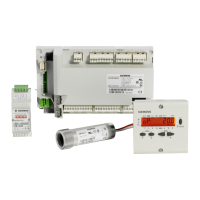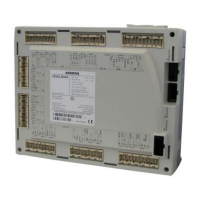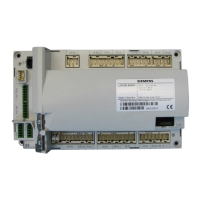LMV Series Technical Instructions
Document No. LV3-1000
SCC Inc. Page 25 Section 5
Changing the VSD Shift High and the VSD Shift Low values limits the amount of trim. This is done
by cutting down the range of the 4-20mA signal, not re-spanning the 4-20mA signal. In other
words, each 0.4mA of signal change will always equal 1% VSD trim. This relationship always
holds true and is completely independent of the setting of VSD Shift High and VSD Shift Low.
2. Set the VSD shift attenuation. This parameter is used to limit the amount of VSD shift at points
lower than high fire (P9). A setting of 100% means maximum shift attenuation (there will be no shift
at low fire and maximum shift at high fire). A setting of 0% means no shift attenuation (the amount
of shift at any point (P1 thru P9) will be the same as is commanded by the 4-20mA signal). This can
also be changed at any point in time, even with the burner running, so if the exact value is not
known a conservative approach (a higher value) is recommended.
a. VSD Shift Attenuation = parameter 549 for Fuel 0, parameter 569 for Fuel 1
3. Set the VSD shift delay. This parameter is used to delay the VSD shift after ignition. The timing for
this parameter starts after the LMV3 reaches phase 60. If the ignition speed shift is also being used,
the amount of VSD shift used for ignition will be retained until this delay times out. This delay can be
used to give the O
2
sensor time to obtain a valid reading after light off, or it can be used to run the
burner rich for a set period of time after ignition to heat up the burner mesh or combustion
chamber. The range is 0 to 255 seconds.
a. VSD Shift Delay = parameter 550 for Fuel 0, parameter 570 for Fuel 1
4. Set the Shift Limit Response. This parameter determines the reaction of the LMV3 when the shift
limits (VSD Shift Low and VSD Shift High) are reached. Three options are available (0 = warning only,
1 = warning and VSD shift deactivation, 2 = burner shutdown).
a. Shift Limit Response = parameter 552 for Fuel 0, parameter 572 for Fuel 1
5. Set the Shift Limit Time. This parameter serves as a buffer timer for the selected Shift Limit
Response. Whichever action is selected by the Shift Limit Response, this will delay that action for
the set amount of time. The range is 0-3600 seconds (60 minutes). A setting of 0 will deactivate the
feature.
a. Shift Limit Time = parameter 551 for Fuel 0, parameter 571 for Fuel 1
6. Set the LMV3 response for an out of range (invalid) 4-20mA signal. Three options are available (0 =
no VSD speed shift (warning message displayed), 1 = lockout, 2 = no VSD speed shift (warning
message displayed).
a. Invalid Analog In = parameter 204
7. Now that the VSD speed shift is configured, it can be activated. Five different options are available
(0 = deactivated, 1 = activated, 2 = activated with analog input test, 3 = activated with ignition speed
shift, 4 = activated with analog input test and ignition speed shift).
a. VSD Speed Shift = parameter 530

